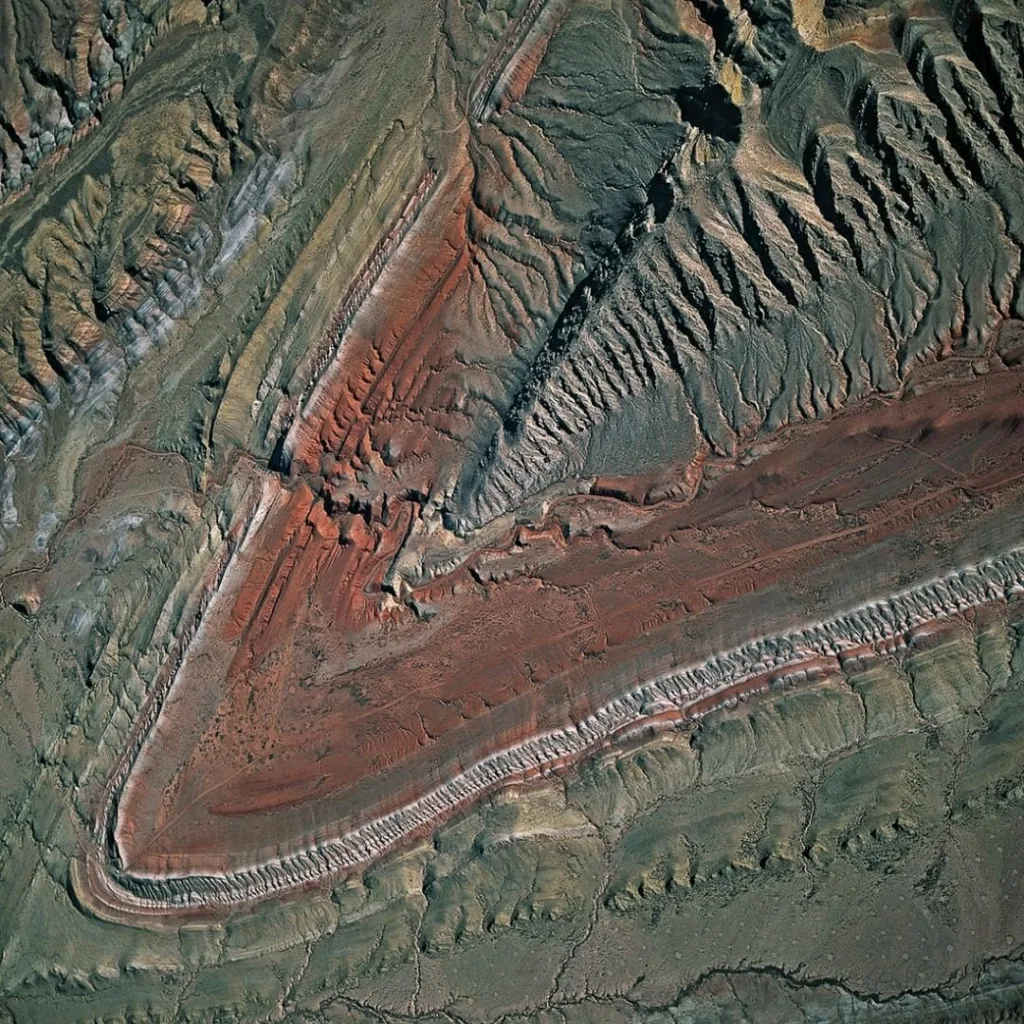An anticline is a geological fold in which the layers of rock are bent upward into an arch shape. When the axis of this fold is not horizontal, but instead plunges downward at an angle, it is called a plunging anticline. Plunging anticlines are common in areas of compressional stress, such as mountain ranges.
In map view, a plunging anticline appears as a U-shaped or V-shaped pattern that points in the direction of the plunge. This pattern is created by the bending of the rock layers, which causes them to slope downwards towards the axis of the fold. The limbs of the fold, which are the sloping sides of the U or V shape, are composed of the same layers of rock that make up the rest of the surrounding area.
A cross-section at a right angle to the axis of a plunging anticline looks the same as any other anticline, with a convex upward shape. However, when viewed from a different angle, such as alng the axis of the fold, the anticline appears to plunge downward into the ground, hence the name.
Plunge is the vertical angle between the horizontal plane and the axis or line of maximum elongation of a feature. In the case of a plunging anticline, this angle is measured along the axis of the fold. The angle of plunge can vary widely, from nearly horizontal to nearly vertical, depending on the amount of compression and the type of rock involved.
Plunging anticlines can have important implications for the oil and gas industry, as they often trap hydrocarbons in the folded layers of rock. The upward arching of the layers can create a dome shape that can serve as a reservoir for oil or gas. However, the angle of plunge can also make it difficult to extract these resources, as the drilling must be angled to follow the shape of the fold.
Plunging anticlines are an important geological feature that can provide insight into the history of the Earth’s crust and the forces that shape it. By studying these folds, geologists can learn more about the formation of mountains and the processes that create valuable mineral resources.
What Causes A Plunging Anticline?
A plunging anticline is caused by the folding of rock layers due to compressional stress. This type of anticline has a hinge line that is inclined at an angle to the horizontal plane, causing the fold to plunge downwards. The angle of the hinge line determines the degree of plunging, with steeper angles resulting in a more pronounced plunge. The formation of a plunging anticline can also be affected by the nature of the rock layers, thir thickness, and the intensity and direction of the compressional stress. The resulting structure of a plunging anticline can have important implications for the exploration and production of oil and gas reserves, as the folding and tilting of rock layers can create traps that can contain hydrocarbons.

How Do You Know If Your Anticline Is Plunging?
To determine if an anticline is plunging, one can observe the U-shaped or V-shaped pattern it forms in map view, which closes or points in the direction of its plunge. Additionally, a cross-sectional view taken at a right angle to the axis of the anticline will show the same pattern as an ordinary anticline. In summary, the key indicators of a plunging anticline are its U-shaped or V-shaped pattern in map view and its similarity to an anticline in cross-sectional view.
What Does Plunging Mean In Geology?
Plunging is a term used in geology to describe the angle between the horizontal plane and the axis or line of maximum elongation of a geological feature. This angle is measured along the axis of a fold, which is a bend or curve in a rock layer. Plunge is an important concept in structural geology, which is the study of the deformation and movement of rocks in the Earth’s crust.
To understand plunge, it is helpful to consider the related concept of dip. Dip is the angle between a rock layer and a horizontal plane. Dip is measured along the limbs of a fold, which are the two sloping sides of the fold. Plunge and dip are related but distinct concepts. Plunge is measured along the axis of a fold, whereas dip is measured along the limbs.
Plunge is an important concept in the interpretation of geological structures. For example, the plunge of a fold can provide information about the direction and intensity of the forces that caused the fold to form. Plunge can also be used to interpret the orientation of faults, which are fractures in the Earth’s crust where rocks have moved relative to each other.
Plunging is a term used in geology to describe the angle between the horizontal plane and the axis or line of maximum elongation of a geological feature, measured along the axis of a fold. It is an important concept in structural geology and can provide information about the forces that case geological structures to form.
Conclusion
A plunging anticline is a fold in rock formations that is caused by compressional stress. It is characterized by a U-shaped or V-shaped pattern in map view that points in the direction of plunge. The vertical angle between the horizontal plane and the axis or line of maximum elongation of the fold is known as plunge. Cross-sections at a right angle to the axis of a plunging anticline look the same as an anticline. Understanding the characteristics of plunging anticlines is important in geology and can proide valuable insights into the geological history of a region. By identifying and studying these folds, geologists can better understand how rock formations were formed and how they have evolved over time.
